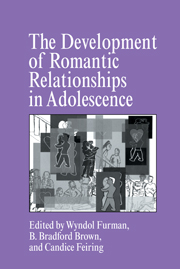Book contents
- Frontmatter
- Contents
- Contributors
- Foreword
- Acknowledgments
- 1 Missing the Love Boat: Why Researchers Have Shied Away from Adolescent Romance
- Part I Processes in Romantic Relationships
- Part II Individual Differences in Romantic Relationships
- Part III The Social Context of Romantic Relationships
- 10 Adolescent Romance and the Parent-Child Relationship: A Contextual Perspective
- 11 Romantic Relationships in Adolescence: The Role of Friends and Peers in Their Emergence and Development
- 12 “You're Going Out with Who?”: Peer Group Influences on Adolescent Romantic Relationships
- 13 The Cultured and Culturing Aspects of Romantic Experience in Adolescence
- 14 What's Love Got to Do with It? Adolescents' and Young Adults' Beliefs About Sexual and Romantic Relationships
- Part IV Conclusion
- Author Index
- Subject Index
10 - Adolescent Romance and the Parent-Child Relationship: A Contextual Perspective
Published online by Cambridge University Press: 05 October 2014
- Frontmatter
- Contents
- Contributors
- Foreword
- Acknowledgments
- 1 Missing the Love Boat: Why Researchers Have Shied Away from Adolescent Romance
- Part I Processes in Romantic Relationships
- Part II Individual Differences in Romantic Relationships
- Part III The Social Context of Romantic Relationships
- 10 Adolescent Romance and the Parent-Child Relationship: A Contextual Perspective
- 11 Romantic Relationships in Adolescence: The Role of Friends and Peers in Their Emergence and Development
- 12 “You're Going Out with Who?”: Peer Group Influences on Adolescent Romantic Relationships
- 13 The Cultured and Culturing Aspects of Romantic Experience in Adolescence
- 14 What's Love Got to Do with It? Adolescents' and Young Adults' Beliefs About Sexual and Romantic Relationships
- Part IV Conclusion
- Author Index
- Subject Index
Summary
The emergence of romantic relationships in early adolescence seldom has been examined within a contextual framework. To date, most theoretical writing on romantic relationships in adolescence has focused on the intraindividual developments characteristic of the adolescent years presumed to affect youngsters' capacity for, and interest in, intimate relationships with age-mates. Much of this work has been informed by psychoanalytic (Freud, 1958), Eriksonian (Erikson, 1959), and Sullivanian views of adolescent development (Buhrmester & Furman, 1987; Furman, this volume; Furman & Wehner, 1994; Sullivan, 1953). Among the factors thought to influence the emergence and progression of romantic relationships are the biological changes of puberty (believed to stimulate interest in sexuality and, consequently, in romance), the onset of abstract thinking (believed to increase youngsters' social cognitive abilities and, accordingly, their capacity for engagement in more interpersonally sophisticated relationships), and changes in individuals' need for intimacy (believed to steer youngsters to relationships that integrate emotional intimacy and sexuality). Empirical research on the subject, sparse as it is, has focused mainly on the meaning and nature of intimate relationships to individual adolescents – how young people view romantic relationships, what takes place within romantic dyads, and what adolescents seek in their intimate partners (e.g., Feiring, 1996).
- Type
- Chapter
- Information
- The Development of Romantic Relationships in Adolescence , pp. 235 - 265Publisher: Cambridge University PressPrint publication year: 1999
- 67
- Cited by

